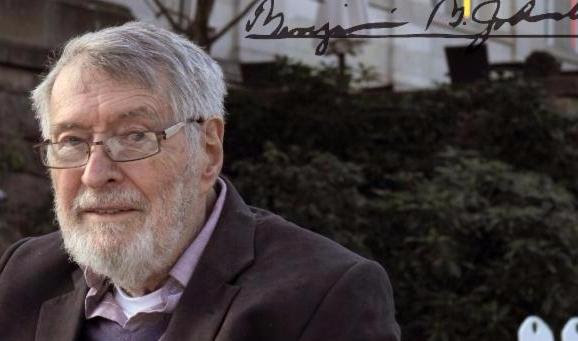
Tomorrow, famed microtonal/just intonation composer Ben Johnston turns ninety. To celebrate his 90th birth year, the Kepler Quartet releases the third and final volume of their series of Johnston’s string quartets in April on New World.
The Original New Music Community

Tomorrow, famed microtonal/just intonation composer Ben Johnston turns ninety. To celebrate his 90th birth year, the Kepler Quartet releases the third and final volume of their series of Johnston’s string quartets in April on New World.
March 4. Knitting Factory: Brooklyn, NY. Michael Daves album release concert.
Michael Daves was certainly apt in titling his debut solo album Orchids and Violence. The album presents twenty-four tracks: twelves songs realized with both a bluegrass band and an electric band. Mirroring the album, the album release concert featured both groups, both fronted by Daves.
There is something so compelling about seeing six musicians huddled around a single microphone, weaving in and out of each other as they take turns playing solos. In the bluegrass set, Daves was supported by five amazingly talented musicians. Noam Pikelny (banjo), Brittany Haas (fiddle), and Jake Jolliff (mandolin) play these incredibly virtuosic solos without any effort. Larry Cook (bass) provided a solid backbone, and even took a few well placed bass solos, illustrating his skill as a performer. Jen Larson provided a perfect compliment to the twang of Daves tenor. This band breathes new life into these songs, songs Daves identifies as old bluegrass songs, pre-bluegrass songs, and murder ballads. Guest Tony Trischka also joined the stage toting his cello banjo for a few songs, adding another layer of depth to the electric texture of the bluegrass band.
For the second set, Daves returned to the stage with Kid Millions on drums and Jessi Carter on electric bass. While the bluegrass band was light and buoyant, the electric band was muddy and heavy. The heavily distorted guitar seemed to grow out of the tone of the electric bass. Halfway through this set Daves asked the audience if they recognized any of these songs from the first set. In response to a few fans cheering, he laughed and said he wasn’t sure if it was a good thing or a bad thing, but that was the point of the album. I spent much of this set thinking about Daves approach to the electric guitar. I feel like this guitar sound was very important to Daves’ concept for this album. Honestly, I feel like Daves is experimenting with something in this configuration, though I’m not sure exactly what it was, or if it was entirely successful. This band brought something heavy and raw to these songs that the bluegrass band simply couldn’t. That being said, the guitar completely dominated these songs, with a thick layer of distortion not adding to the music, but instead keeping me from it.
Orchids and Violence is currently available from Nonesuch Records.

In honor of International Women’s Day, violinist Ariana Kim has released a video of her performance of Augusta Read Thomas’s Incantation for solo violin (1995). I’ve long loved Incantation – it is one of Thomas’s most beautiful works: poignant, supple, and exquisitely well-paced.
Kim’s current project is Routes of Evanescence, a recording of works by women composers.
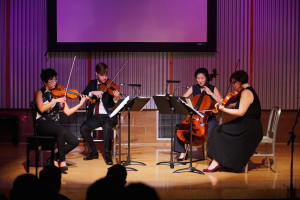 On Saturday, February 27, 2016 Boston Court in Pasadena hosted the Los Angeles-based composer collective Synchromy and The Argus Quartet who performed no fewer than 9 works of new music including three world premieres. A nice crowd filled the Marjorie Branson space to hear a concert titled walkabout that featured narration, video projections and music from seven different composers inspired by place and surroundings.
On Saturday, February 27, 2016 Boston Court in Pasadena hosted the Los Angeles-based composer collective Synchromy and The Argus Quartet who performed no fewer than 9 works of new music including three world premieres. A nice crowd filled the Marjorie Branson space to hear a concert titled walkabout that featured narration, video projections and music from seven different composers inspired by place and surroundings.
The first piece on the program was Sabina, by Andrew Norman from A Companion Guide to Rome, a collection of nine musical portraits based on churches in Rome. As Norman writes in the program notes: “The music is, at different times and in different ways, informed by the proportions of the churches, the qualities of their surfaces, the patterns in their floors, the artwork on their walls, and the lives and legends of the saints whose names they bear. The more I worked on these miniatures, the less they had to do with actual buildings and the more they became character studies of imaginary people, my companions for a year of living in the Eternal City.”
Sabina was performed on this occasion by Clara Kim of the Argus Quartet as a violin solo. This begins with a series of quiet whispers that evoke a light breeze or the wind whistling softly through the stone arches of a church. This builds gradually into some lovely notes and runs of sound that unfold to create a more active, complex texture. The playing becomes more animated through an interweaving of sounds – much like a tapestry of colored threads – but with an overall warmth and wistfulness that is very appealing. All of this was performed with great skill by Ms. Kim who kept everything balanced and moving crisply forward. Towards the conclusion the pace slowed and a series of singularly high, thin notes coalesced into what could have been a simple hymn tune to finish out. For those who are familiar with Norman’s orchestral works – full of power and fury – Sabina reveals a more sensitive compositional touch and is a beautifully sketched likeness of a charming subject.
Cloud Trio, by Kaija Saariaho was next and a brief spoken introduction by narrator Chelsea Fryer was given about the instrumentation prior to the playing of this piece. As quoted from the program notes: “In this piece, the three instruments all have different tasks and functions, they represent very different aspects of string playing. These tasks are sometimes very concrete: the violin tends to behave as an echo or reverberation, the viola creates new clouds next to the existing ones and the cello often has a function of a shadow to the upper instrumental lines.”
Images of clouds moving slowly across a blue sky were projected on the screen above the stage and Cloud Trio began with smooth, sustained lines from each instrument that produced some enchanting harmony. As the piece progressed there was a more active feel in the violin – almost like the falling of rain drops – and a rapid, complex intertwining of the parts. Over the four sections of this work each of the instruments rose to the top of the texture only to be replaced with another, and this produced a fascinating series of combinations. The volume, rhythm or complexity would increase and then subside, and the feeling was variously mysterious, lethargic or dramatic, as if a series of different clouds were drifting by. A captivating violin solo emerged just as the piece finished and the Argus players carefully drew out each of the nuances in this well-played performance. Cloud Trio is imaginative music that invites the listener to conjure up vivid atmospheric images.
The world premiere of funeral song for the people of the ruined cities, by Zaq Kenefick followed and for this piece the full Argus Quartet took the stage. This music is an exploration of what hypothetical folk music might sound like for a people who have lost their cultural memory after some long-ago calamity. A short narration preceded the start of this and an anxious trill in the violin opened the piece with a strong sense of foreboding. Tutti passages followed with a growling sound in the cello and strong strumming of the viola. There is a rough, edgy feel to this – all is unsettled and seemingly in chaos. Despite its short playing time, funeral song for the people of the ruined cities is an expressive and unnerving musical glimpse into the grim future of a people who must exist without a past.
 (This is an expansion of an earlier post for a concert ultimately postponed due to snowstorm Jonas in January)
(This is an expansion of an earlier post for a concert ultimately postponed due to snowstorm Jonas in January)
Augustus Arnone performs a double bill of Milton Babbitt’s solo piano works including the complete Time Series, at Spectrum, Sunday March 6, at 12-5 pm (12 and 3:30)
This year marks the centenary of the legendary composer Milton Babbitt (1916-2011). To my ears, his extensive body of piano works especially channels his singular charm as a raconteur. Over the decades a number of pianists have championed some of his major piano works, for instance Robert Helps and Robert Miller performing and recording his Partitions (1957) and Post-Partitions (1966) in early days and much more recently Marilyn Nonken did as much with Allegro Penseroso (1999). Babbitt’s Reflections for piano and synthesized tape (1975) has been performed by the likes of Anthony de Mare, Martin Goldray, Aleck Karis, and Robert Taub, the latter two of whom also recorded it. Robert Taub and Martin Goldray recorded and released full-length CDs. Alan Feinberg too presented stellar renditions of Minute Waltz (1977), Partitions (1957), It Takes Twelve to Tango (1984), Playing for Time (1979), and About Time (1982) on a 1988 CRI CD.
 Yet only one pianist has earned the distinction of presenting the entire oeuvre of Babbitt’s solo piano works in concert. And that is Augustus Arnone, who performed the entire set, spread over two concerts, in 2008. In honor of the Babbitt centenary, Arnone is performing the entire set again (this time spread over three concerts) at Spectrum on Ludlow in NYC. Due to a postponement caused by storm Jonas in January, Arnone is performing the second and third concerts in one afternoon this weekend!
Yet only one pianist has earned the distinction of presenting the entire oeuvre of Babbitt’s solo piano works in concert. And that is Augustus Arnone, who performed the entire set, spread over two concerts, in 2008. In honor of the Babbitt centenary, Arnone is performing the entire set again (this time spread over three concerts) at Spectrum on Ludlow in NYC. Due to a postponement caused by storm Jonas in January, Arnone is performing the second and third concerts in one afternoon this weekend!
The largest work on the program is Canonical Form (1983) which I’ve heard several Babbitt aficionados recently describe as their “favorite” and “most beautiful” Babbitt composition. The most recent work is The Old Order Changeth (1998). Arnone’s performance also presents a rare opportunity to hear the entire ‘The Time Series’ (Playing For Time (1977), About Time (1982), Overtime (1987)), the last part of which has never been released on a commercial recording. This much constitutes concert II, the first half of this Sunday’s double bill, which starts at 12 noon.
In the final concert (concert III) which starts at 3:30, Arnone presents a variety of works spanning nearly all of Babbitt’s professional career, from the mid 1940s through the remainder of the 20th century and beyond. Tutte Le Corde (1994) represents Babbitt’s most streamlined and ingratiating late style, which is a nice inclusion for the final recital of the series. On this recital we’ll also be treated to some of Babbitt’s wittiest and pithiest: Minute Waltz (1977) and It Takes Twelve to Tango (1984), which are perhaps the only Babbitt works to clearly project rhythms associated with a familiar genre. It Takes Twelve to Tango leaves us unsure whether to imagine a single 12-legged Argentinian dancing spider or a communal square dance gone dodecahedral! Either way, brilliant sparks fly from these eccentric collisions of tradition and avant garde.
Babbitt’s Three Compositions for Piano (1947), the earliest work in the series, is to my ears the closest Babbitt ever came to neo-classicism, its first movement being a clean perpetuum mobile and its second movement a veiled tribute to Schoenberg’s expressive piano textures. While Duet (1956) is the closest Babbitt ever came to a lullaby, his Semi-Simple Variations, of the same year, is perhaps his jazziest jaunt on the ivories, an adventure amusingly exploited in the Bad Plus and Mark Morris Dancers’ adaptation.
Of course the series wouldn’t be complete without Babbitt’s most uncompromising trailblazing Partitions (1957) and Post-partitions (1966). Nowhere is his engenius originality more startlingly on display than in these works. In Partitions in particular, the activation and deactivation of various high, low, and middle registers of the piano guides the listener through an uncanny but navigable maze of contrapuntal intricacy.
Between the two concerts, at 2:30, will be an interview-discussion between me and Indiana University composer-theorist Andrew Mead, a former student of Babbitt’s at Princeton and author of the acclaimed book An Introduction to the Music of Milton Babbitt (1994, Princeton University Press) and many articles. This will also be an opportunity for questions from the audience. Whether you’ve been merely curious about Milton Babbitt’s music and legacy, or are already a long-time follower, this is an opportunity to spend part of the afternoon in the good company of Babbitt’s music and its admirers.
Augustus Arnone: The Complete Piano Works Of Milton Babbitt, Concerts II & III
Sunday March 6, concert II at 12 pm; pre-concert discussion at 2:30; concert III at 3:30.
$20, $15 (Students/Seniors) for each concert or $30/20 for both concerts.
Spectrum, 121 Ludlow St, NYC.
More info: http://www.facebook.com/events/185521401798997/
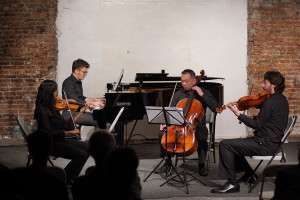 On February 16, 2016, Tuesdays@Monk Space hosted a concert of Cold Blue Music artists in the lively Koreatown district of Los Angeles. A good crowd came out to hear music by Michael Jon Fink, Jim Fox, Michael Byron and Peter Garland. Three premieres were heard including the world premiere performance of In the Village of Hope by Michael Byron.
On February 16, 2016, Tuesdays@Monk Space hosted a concert of Cold Blue Music artists in the lively Koreatown district of Los Angeles. A good crowd came out to hear music by Michael Jon Fink, Jim Fox, Michael Byron and Peter Garland. Three premieres were heard including the world premiere performance of In the Village of Hope by Michael Byron.
The first piece, Vocalise (1979), by Michael Jon Fink, was for piano and performed by the composer. This opened with series of quietly beautiful notes, like the melody from a simple hymn and unfolded with the spare elegance that is the hallmark of Michael Jon Fink’s compositions. The warm acoustics of the cozy Monk Space – with brick walls on three sides – allowed for an extra long duration and decay of the sustained notes, adding to the sense of serenity. Vocalise is not a long piece, but contains all the essential elements of peaceful sensibility that informs this composer’s music.
From a Folio (2013), also by Michael Jon Fink followed, and for this piece of seven movements cellist Derek Stein joined the composer, again on piano. Each of the movements are compact and variously declarative, quietly powerful, unsettling, questioning, solemn or even sorrowful. Sustained cello passages were often set up by a series of simple piano notes or chords, a contrast that proved to be very effective. At other times a soft call and answer pattern between the cello and piano prevailed. The subtle touch on the piano was complimented by the sensitive playing of Derek Stein who discerned the quiet intentions of this work perfectly. The graceful consistency of these seven movements give From a Folio a notable sense of tranquility combined with a satisfying cohesiveness.
The world premiere of In the Village of Hope (2013), by Michael Byron was next, performed by harpist Tasha Smith Godínez, who commissioned the work. This is an ambitious piece, full of constant motion but with an engaging and exotic character. It has a soft, Asian feel and the steady patter of notes fall like raindrops in a warm tropical shower. A light melody in the upper registers is joined in masterful counterpoint below, and the piece glides delicately through several key changes as it continuously unfolds. Listening to the Cold Blue recording of this piece one imagines that the harpist would be a great flurry of motion – but the technique of Tasha Smith Godínez in this performance was superb; her graceful fingers never seemed hurried or her movements labored. The tones from her harp were clear and strong; the lively acoustics of Monk Space made them almost seem amplified. A drier acoustic environment might have served to bring out the intricate texture more clearly. Michael Byron, who was in attendance, admitted to a certain trepidation when he turned in the imposing score, but Ms.Godínez never asked for any changes or modifications and proved more than equal to the task in this performance. In the Village of Hope is a profoundly impressive work, in both its vision and realization.
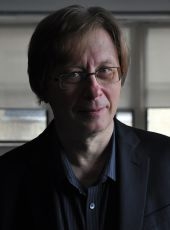
This week in New York, Austrian Cultural Forum celebrates the music of Georg Friedrich Haas. Haas, currently MacDowell Professor of Music at Columbia, is a thoughtful and innovative composer. The two programs curated by ACFNY, both free (with reservations), are excellent opportunities to hear two different facets of his creativity.

On Wednesday February 24th at 7:30 PM at the ACF, JACK Quartet performs String Quartet No. 3 In iij. Noct., a piece that occurs in total darkness.

On February 26 at 8 PM at Bohemian National Hall (321 East 73rd Street), the Talea Ensemble presents the following program of large ensemble and chamber works: La profondeur (2009), for lower instruments, I can’t breathe (2015), a US Premiere that commemorates Eric Garner, played by trumpeter Gareth Flowers, tria ex uno (2001), and …wie stille brannte das Licht (2009), featuring vocal soloist Tony Arnold. James Baker conducts.
Elliott Sharp may sometimes be characterized as a cellular composer, but he is by no means a cellular thinker. Rather, he seems to conceive of things in large swaths of creation, only then removing skins and reconnecting veins until each organism revives by means of unexpected blood flow. The Boreal collects four somewhat recent examples, of which the 2008 title composition, performed here by the JACK Quartet, employs awesome extended techniques, including bows strung with springs and ball-bearing chains, in addition to standard hair.
But through this recording it’s not so much the craft as the art that shines. Like the electric effluvia on the cover photograph, Sharp’s writing emits an attractive aura all its own, leaping from one motif to the next with ionic inevitability. The new bows reveal inner voices in the second movement, which with its sonic forensics swabs the seat of creation for any residue left by whoever last sat there. Whether plying striated territories in the third movement or touching off cyclical measures in the fourth, the musicians are fully present and work their touch to suit the needs of changing topography. It is a piece that would fit comfortably in the Kronos Quartet’s repertoire, but which feels just as much at home in JACK’s hands. Sounding almost electronic yet with such intimacy as to only be renderable in real time, the quieter passages especially highlight the potential of these extensions.
Fearless musicianship is characteristic of the album as a whole and is embodied to its fullest at the fingers of pianist Jenny Lin, who gives Oligosono (2004) more than it ever dreamed of in an interpreted life. Raw technique again pays dividends, forging rhythmic codes through a tactile relationship with the piano strings. Lin handles these messages as if by her very DNA, harmonic overtones reinforcing one another through mechanisms of repetition. Each section is grafted to the ones before and after it (even the first and last carry unheard continuities). The insistence of certain impulses exists not for the sake of minimalism, but to maximize the potential for incidental utterances and hidden voices within the instrument’s architecture. The whole thing feels like a medical test of space-time itself as the depth-soundings of the third and final movement give chase to biological data, savoring the imprints left behind of an entity they cannot ever catch. Here is the piano as machine, the body as instrument.
Proof Of Erdös, written in 2006 and performed by Sharp’s Orchestra Carbon under the direction of David Bloom, is something of a non-portrait. Despite being inspired by the persona of mathematician Pal Erdös, it doesn’t so much illustrate a life as one of its many panels of expression. Here the bowing, while more familiar, sprouts a forest that is less so. Feelings of tension give way to silence and reset. Sharp’s expanse of internality is overrun with genetic details, a mitochondrial frenzy turned inside out, a tuning of the self to the self until there is no self left to tune.
Janáček Philharmonic Orchestra, conducted by Peter Rundel, gives the final reading of the program, performing On Corlear’s Hook (2007) with commitment. The piece is cinematic in scope—think 2001: A Space Odyssey—but works its cosmic drive inward rather than outward. It inhales dark matter with the appetite of a black hole. The vaster instrumental forces at work enhance this feeling of inwardness. Every new shift of texture and color is a veritable terabyte of information compressed into a drop of ink on staff paper. It is the nervous system as metropolis, and sensations as traffic running through its streets. Harp, strings, and brass work together toward a unity that feeds on self-fragmentation. Epic, to be sure, but only the beginning of life.
These pieces are translations: of inside to outside, of colors to emptiness, of stillness to vibration and back again. In them are whispers of screams and vice versa. Together, they are a mirror, cloudy but usable, waiting for the polish of an open ear. Like the void within that ear, Sharp’s is a sonic universe devoid of politics, an environment where one can simply listen, be, and listen to being.
(For more information and samples, please click here.)
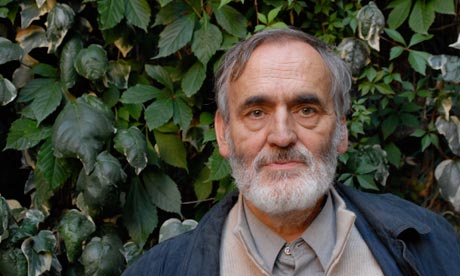 Helmut Lachemann, 80, this November, is one of the most important, original and influential living composers. To hundreds of younger composers whose ambition is to push the boundaries of music and sound beyond its presumed limits, he is a God-like figure, the reigning king of musical post-modernism. Think Stockhausen or Cage, tripled down. Extreme, thrilling, unexpected, visionary, painful, edgy. If he were a Zen master, his mantra would be “Who knows the sound of a beetle lying on its back?”
Helmut Lachemann, 80, this November, is one of the most important, original and influential living composers. To hundreds of younger composers whose ambition is to push the boundaries of music and sound beyond its presumed limits, he is a God-like figure, the reigning king of musical post-modernism. Think Stockhausen or Cage, tripled down. Extreme, thrilling, unexpected, visionary, painful, edgy. If he were a Zen master, his mantra would be “Who knows the sound of a beetle lying on its back?”
For listeners who prefer their “classical” music with a touch of consonance, he is one of those composers whose work is more fun to talk about than to actually listen to.
All of which makes John Kennedy, director of contemporary music for SpoletoUSA, a brave man, indeed, for making the American premiere of Lachemann’s opera Das Mädchen mit den Schwefelhölzern (The Little Match Girl) the centerpiece of this year’s Spoleto Music in Time Series. Conceived on a grand scale, Lachemann’s retelling of the tragic Hans Christian Andersen tale of the little girl who measures out her final hours by striking matches for a moment of warmth on the freezing street, employs 106 musicians and various other theater performers.
Lachenmann refers to his compositions as musique concrète instrumentale, basically a musical language that embraces the entire sound-world made accessible through unconventional playing techniques. According to the composer, this is music
“in which the sound events are chosen and organized so that the manner in which they are generated is at least as important as the resultant acoustic qualities themselves. Consequently those qualities, such as timbre, volume, etc., do not produce sounds for their own sake, but describe or denote the concrete situation: listening, you hear the conditions under which a sound- or noise-action is carried out, you hear what materials and energies are involved and what resistance is encountered.”
To take a simple example, guitarists generally try to limit the sound of nails clacking on strings or accidental glissandos produced by sliding their fingers up and down the strings between chords. Their goal is play as faithfully as possible only the notated sounds. In Lachemann’s musique concrete world, these scratches, squeaks and sighs are all part of the music. Through amplification and a plethora of techniques that he has invented for wind, brass and string instruments, Lachemann creates difficult, uncompromising works that are, like their creator, wholly original. His scores place enormous demands on performers. They may be only works in the modern repertory in which players may need a shower after the piece is finished.
Coming as it does in the 40th Anniversary Year of Spoleto with all the attendant “feel good” celebrations, the programming of such a controversial composer as Lachenmann is a welcome sign that SpoletoUSA that the nation’s best—and probably most financially successful–arts festival is still not afraid to take risks and push the boundaries of original performance. Founder Gian Carlo Menotti would be proud.
To appreciate Lachemann requires listeners and performers to forget whatever inherited notions they may have about beauty in music. “Try to like it,” he often tells audiences about to hear his work for the first time. For those willing to suspend their preconceptions, his music offers great listening experiences and, yes, even a strange kind of beauty.
Lachenman will be in attendance at the Festival and will participate in a conversation between Kennedy on May 27 (including a performance of Lachenmann’s piece Got Lost); a performance of Lachenmann’s Ein Kinderspiel and Kenndy’s Spoletudes on June 4, and a performance by Stephen Drury of Lachenmann’s monumental piano solo Serynade, plus Oscar Bettison’s 2014 work for small ensemble An Automated Sunrise (for Joseph Cornell).
Have a comment? Leave it on our Facebook page. The robot spammers have taken over the comments here.

Eminent composer, college professor, and Lutoslawski scholar Steven Stucky has died, aged 66. The cause was brain cancer. Below, listen to one of his beguiling works, the Notturno movement from Serenade for Wind Quintet.